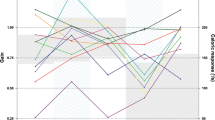Abstract
The vestibulospinal aspects of vestibular function are commonly neglected in the evaluation of alcohol-induced intoxication. Thus, in the present study the effect of an acute intoxication with a low or moderate quantity of alcohol was examined with respect to the equilibrium in 30 healthy subjects. The blood alcohol concentration (BAC) was measured 30 min after the ingestion of the last alcohol, ranging between 0.22 and l.59‰. Stability of stance was quantified by static platform posturography in Romberg-test conditions with eyes open and eyes closed. Among other parameters, the average body sway path (SP) and area of body sway (SA) were assessed. Posturography revealed a significant increase in body sway. There was a positive correlation between SA (or SP) and BAC both with eyes open and eyes closed. Multiple group comparisons revealed that the large-alcohol-dose group (BAC ≥ 1.0‰) could be clearly differentiated from test cases with BAC lower than 0.8‰. Sway area was the most sensitive parameter for detecting increased body sway after alcohol ingestion. The area increase, present not only with eyes closed but with eyes open, revealed an inadequate compensation of the ethanol-induced ataxia by visual stabilization. The Romberg’s quotient, which denotes eyes closed relative to eyes open, remained constant. The increase in sway path with eyes closed showed an omnidirectional sway. A comparison of the sway pattern of subjects after acute ethanol ingestion with the data of patients with permanent cerebellar lesions suggested that the acute effect of alcohol resembles that of a lesion of the spinocerebellum. This finding contrasts with earlier studies, which postulated an acute effect of ethanol resembling that in patients with an atrophy of the anterior lobe of the cerebellum due to chronic alcohol abuse. In seven cases of the lower dose group (BAC ≤ 0.8‰), a reduction in body sway after alcohol ingestion was observed. This finding may be consistent with a dose-related biphasic action of alcohol, which – besides its well-known depressant effects with high doses – also shows stimulatory action with small doses.
Similar content being viewed by others
Author information
Authors and Affiliations
Additional information
Received: 5 January 1998 / Received in revised form: 3 July 1998
Rights and permissions
About this article
Cite this article
Nieschalk, M., Ortmann, C., West, A. et al. Effects of alcohol on body-sway patterns in human subjects. Int J Leg Med 112, 253–260 (1999). https://doi.org/10.1007/s004140050245
Issue Date:
DOI: https://doi.org/10.1007/s004140050245




